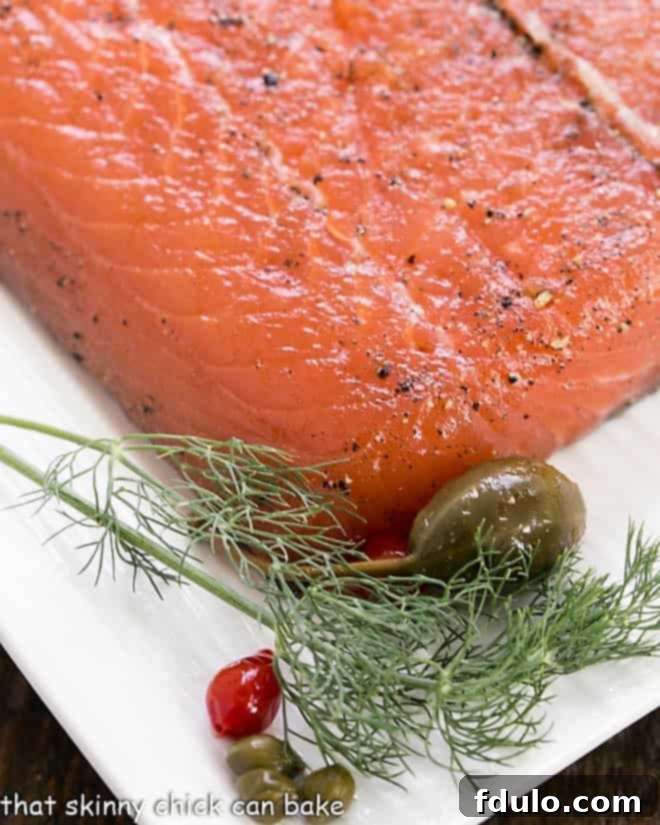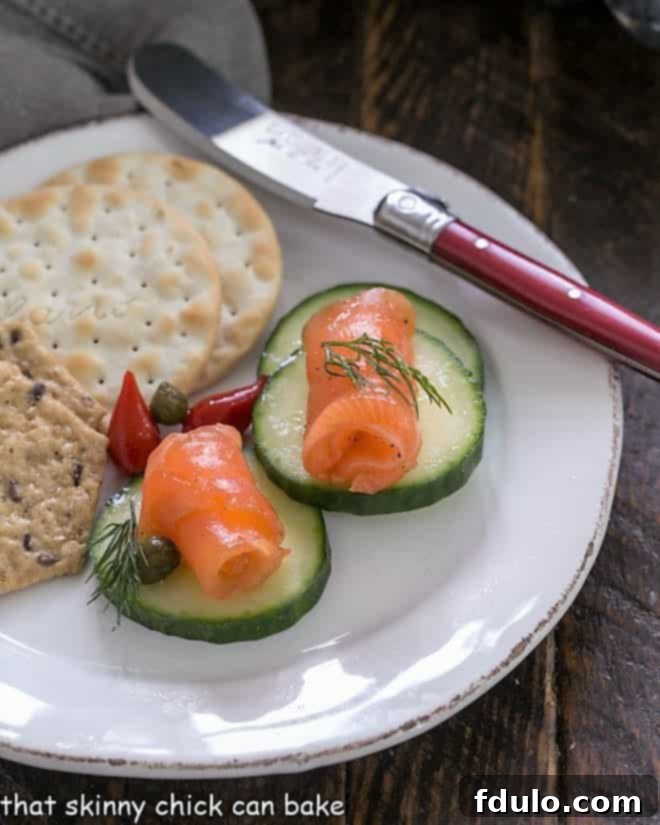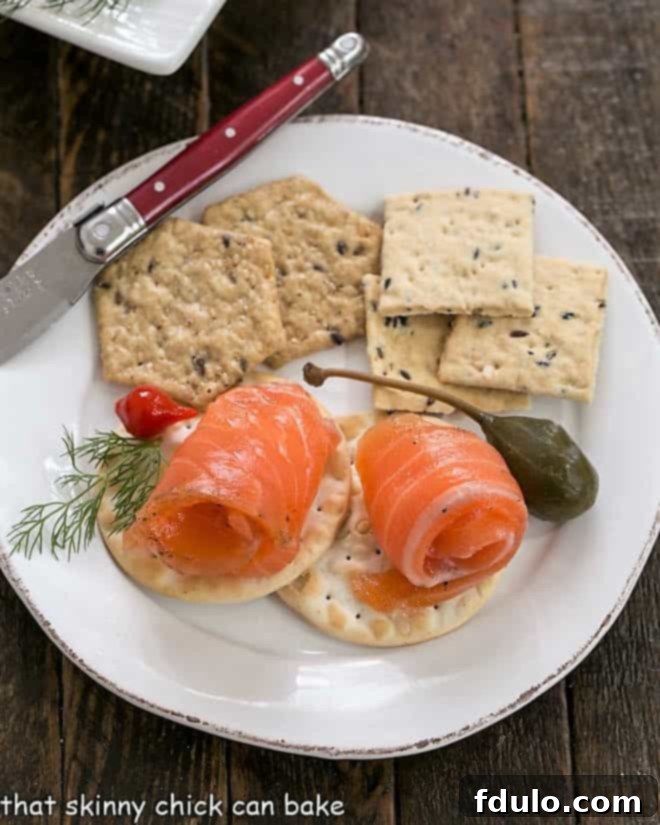Gravlax, often celebrated as Scandinavian cured salmon, is a culinary masterpiece that is surprisingly simple to prepare at home. This traditional delicacy, requiring minimal ingredients like salt and sugar, primarily demands patience. The transformative process occurs over 3 to 4 days as the salmon rests in the refrigerator, meticulously curing until it reaches its peak of perfection, ready for thin, elegant slices. The wait, without a doubt, is profoundly rewarding.
Imagine the delight and admiration of your guests when you proudly reveal that this exquisite, sliced dry-brined salmon, with its vibrant color and delicate texture, was expertly crafted right in your own kitchen. Gravlax is truly a luxury item, typically found in gourmet delis, that becomes an accessible indulgence when you master its preparation at home. Discover how to make gravlax and elevate your next breakfast, brunch, or special occasion gathering into an unforgettable culinary experience.

Why You Must Make This Homemade Gravlax Recipe
Creating your own gravlax isn’t just about making food; it’s about embarking on a rewarding culinary journey that yields a truly impressive result. Here are compelling reasons why this Scandinavian cured salmon recipe should be on your must-try list:
- Effortlessly Simple with Minimal Ingredients: Despite its gourmet appeal, gravlax requires only a handful of staple ingredients – primarily fresh salmon, salt, sugar, and dill. The preparation is hands-on for mere minutes; the bulk of the “work” is done by time and refrigeration, allowing the salmon to “cure” itself.
- Complete Control Over Flavor Profile: When you make gravlax at home, you become the master of its taste. You can adjust the balance of salt and sugar, experiment with different herbs beyond dill (though dill is classic!), or introduce subtle notes with spices and spirits. This customization ensures your gravlax perfectly suits your palate.
- Impress Your Guests Beyond Expectation: There’s something inherently luxurious and sophisticated about serving homemade gravlax. Its beautiful presentation, delicate texture, and rich flavor will undoubtedly amaze everyone at your table. It’s a fantastic conversation starter and a testament to your culinary prowess, making any meal feel incredibly special.
- Cost-Effective Gourmet Indulgence: Purchasing high-quality gravlax from specialty stores can be quite expensive. By making it yourself, you enjoy the same gourmet quality, often superior freshness, at a fraction of the cost. This allows you to savor this exquisite dish more frequently without breaking the bank.
- A Unique and Healthy Addition to Your Repertoire: Gravlax is not only delicious but also a relatively healthy protein source, rich in omega-3 fatty acids. Adding this curing technique to your culinary skills opens up a world of possibilities for future seafood preparations, enriching your cooking repertoire.
Our recent Fourth of July celebration deviated significantly from the typical American barbecue fare. Instead, we curated a globally inspired menu featuring vibrant Brazilian cocktails, this exquisite Scandinavian cured salmon, a whimsical grasshopper pie, and a classic grilled dish. This eclectic mix was born from our tradition of gathering with neighbors each Independence Day for a potluck dinner followed by fireworks.
It presented the perfect opportunity to test new recipes for the blog, and this gravlax was a star. Unlike my family, who tend to offer vague feedback, my friends are wonderfully adventurous eaters and masters of articulate reviews, providing me with invaluable, quotable insights. Their detailed feedback is a welcome improvement over the usual “good stuff” or “you don’t have to make this again” I often get from my usual crew. What’s more, they weren’t just interested in eating the gravlax; they were genuinely curious about HOW to make it, which is the ultimate compliment for any recipe developer!

How to Make Gravlax AKA Cured Salmon: A Step-by-Step Guide
The art of making gravlax is steeped in history, dating back to the Middle Ages when Nordic fishermen would salt salmon and bury it in the sand above the high-tide line to ferment – a technique that literally translates to “grave salmon.” Today, the process is far more refined and hygienic, yet it retains its core principle: curing salmon with a simple mixture. Here’s how you can create this delicious cured salmon at home:
- The Curing Process Explained: Modern gravlax involves coating fresh salmon fillets with a precise mixture of salt and sugar, which acts as a powerful dehydrating and flavor-infusing agent. This mixture draws moisture out of the fish through osmosis, transforming its texture and preserving it. Fresh dill sprigs are then layered over the salmon, imparting their characteristic herbaceous aroma. My particular recipe received an optional sprinkle of Cognac, adding a layer of complex, aromatic depth, before settling into the refrigerator for half a week. The fillets were weighed down (I often use two cast-iron popover pans for this purpose), and diligently flipped every 12 hours to ensure even curing.
- Preparation of Your Curing Station: Begin by lining a rimmed baking sheet generously with plastic wrap. This is crucial for containing any liquid released during the curing process and for easy cleanup. Ensure the plastic wrap extends well beyond the edges, allowing you to tightly encase the salmon later.
- Preparing the Salmon: Place your salmon fillet, skin-side down, on the prepared baking sheet. It’s imperative to meticulously inspect the fillet for any pin bones. Run your fingers along the flesh; if you feel any, use a pair of clean pliers or fish tweezers to gently pull them out. A bone-free fillet ensures a smooth and enjoyable eating experience.
- Crafting and Applying the Dry Brine: In a small bowl, thoroughly mix together the dry brine ingredients: salt, sugar, and any additional spices like freshly ground black pepper. This mixture is the heart of the cure. Sprinkle it evenly and generously over the entire flesh side of the salmon fillets, ensuring every part is covered. Next, arrange fresh dill sprigs artfully over the brined salmon. If using, drizzle the Cognac (or your preferred spirit) evenly over the dill and salmon.
- Weighting and Wrapping for Optimal Cure: Once the brine and aromatics are in place, cover the salmon tightly with another layer of plastic wrap, ensuring it’s in direct contact with the fish. Then, place a second baking sheet (flat side down) directly on top of the wrapped salmon. The final step is to place a heavy object – such as bricks wrapped in foil, a stack of heavy cans, or even a cast-iron skillet – on top of the upper baking sheet. This continuous pressure is vital as it helps to press the brine mixture firmly into the fish, facilitating the osmosis process and ensuring a uniform cure.
- The Patience Game: Flipping and Waiting: The curing process typically takes 3 to 4 days. Every 12 hours, you must diligently flip the salmon pieces. To do this, carefully unwrap the salmon, drain any accumulated liquid from the baking sheet (this liquid is moisture drawn from the fish), flip the fillets over, and re-cover them with fresh plastic wrap. Reapply the top baking sheet and heavy weight. This consistent flipping ensures both sides of the fillet are exposed to the curing mixture and gravity, leading to an even cure. Continue this routine for the full 3-4 day period until the salmon’s texture has firmed up and it has taken on a translucent, cured appearance.
Essential Tips for Making Perfect Gravlax Every Time
Gravlax, with its minimal ingredients and straightforward preparation, is truly a must-make dish. The singular, most important requirement for success is patience, as you’ll need to wait 3 to 4 days before you can finally slice into your delectable creation. To ensure your homemade gravlax is nothing short of perfection, consider these invaluable tips:
- Prioritize High-Quality Salmon: The foundation of exceptional gravlax is premium salmon. I consistently choose to visit my local fishmonger rather than a generic grocery store, as they typically offer the freshest, highest-quality, and often wild-caught salmon available. Avoid salmon that appears mushy or discolored, as this will compromise the final texture and flavor of your gravlax. Opt for firm, vibrant fillets with skin on, as the skin helps hold the fish together during the curing process.
- Mind the Dill Balance: While dill is the quintessential herb for gravlax, subtlety is key. A nuanced dill flavor complements the salmon beautifully, enhancing its natural taste without overpowering the delicate seafood. Other wonderful herbs and spices you might consider in your brine include fennel seeds for a gentle licorice note, anise, coriander, caraway, or a touch of citrus zest (lemon or orange) for brightness. Experimentation can lead to delightful variations.
- PRO-Tip: The Role of Alcohol: Adding alcohol, such as Cognac, is entirely optional but highly recommended for those seeking a more complex and sophisticated flavor profile. Alcohol, much like salt, acts as a flavor enhancer and can introduce intriguing aromatic layers. Besides Cognac, common choices include vodka, gin, whiskey, or the traditional Scandinavian spirit, aquavit, which often contains caraway and dill notes.
- Patience is Truly a Virtue: This cannot be stressed enough. The salt and sugar mixture requires ample time to penetrate the salmon flesh, draw out excess moisture, and properly preserve the fish. Rushing this process will result in an under-cured product with an undesirable texture. Trust the process; the waiting period is absolutely worth it for the transformed flavor and texture.
- PRO-Tip: Set Reminders: It’s easy to forget to flip your salmon every 12 hours, especially when it’s tucked away in a refrigerator. Utilize your calendar or phone to set recurring reminders. I often place mine in a secondary basement refrigerator, and out of sight can easily lead to out of mind! Consistent flipping ensures an even cure.
- Choose Your Weights Wisely: The pressure applied to the salmon is crucial for effective curing. Don’t hesitate to use whatever heavy objects you have on hand: bricks (cleanly wrapped in foil), a heavy cast-iron skillet, large cans of food, or even a stack of cookbooks. The continuous pressure ensures intimate contact between the salt and sugar mixture and the fish, facilitating optimal moisture extraction and flavor infusion.
- Master the Art of Slicing: For the best aesthetic and textural experience, aim to slice your gravlax as thinly as possible. Use a very sharp, long slicing knife or a dedicated salmon knife. Slice from the long end of the fillet to the other, at a slight angle, almost parallel to the cutting board. My early attempts often resulted in slices that weren’t as thin as I preferred, so practice truly makes perfect here. Sharpness of the knife is paramount to achieving those delicate, translucent slivers.
- Proper Storage and Shelf Life: Once cured, remove the gravlax from the brine, pat it dry, and scrape off any excess dill or spices. It can be stored, tightly wrapped in plastic wrap or vacuum-sealed, in the refrigerator for up to 5-7 days. For longer storage, gravlax freezes beautifully for up to a month.
I knew I had a culinary winner on my hands when one of my guests exclaimed, “This is magnificent smoked salmon!” with Bill, notoriously my “Mr. Picky Pants,” chiming in with an enthusiastic, “I hope there’s more of this.” Yes, you read that right – Bill was not only eating but enjoying raw, cured salmon! Whoa. Perhaps, just perhaps, this might pave the way for him to try fennel, mint, nuts, or even pineapple again one day. A cook can certainly dream, can’t she? I’ve also successfully created delightful canapés using a fantastic gravlax recipe by Dorie Greenspan, proving its versatility.

Frequently Asked Questions About Gravlax
Gravlax is a traditional Scandinavian (primarily Swedish) dish consisting of raw salmon that has been cured for several days. The curing process involves a dry brine mixture typically made of salt, sugar, and fresh dill, sometimes with the addition of black pepper, spices, or alcohol like Cognac or aquavit. The curing process draws out moisture from the fish, firming its texture and infusing it with flavor, resulting in a firm, translucent, and incredibly flavorful fillet that is then sliced paper-thin for serving.
While both gravlax and lox are cured salmon, they differ in their preparation. Lox traditionally refers to salmon belly that is cured with a very salty brine (salt only), but it is not typically smoked. The name “lox” comes from the Yiddish word “laks,” meaning salmon. Gravlax, on the other hand, is cured with a combination of salt and sugar, along with dill and often other spices or spirits, and is never smoked. This sugar component gives gravlax a slightly sweeter and more complex flavor profile compared to the purely salty taste of traditional lox.
To make gravlax, you start by preparing a fresh, skin-on salmon fillet (pin bones removed). You then create a dry brine mixture of salt, sugar, and typically freshly ground black pepper. This mixture is generously applied to the salmon, which is then topped with abundant fresh dill sprigs and optionally a drizzle of spirit like Cognac. The salmon is placed on a plastic-lined, rimmed baking sheet, covered with more plastic wrap, and weighted down with another baking sheet and a heavy object. It then cures in the refrigerator for 3-4 days, requiring a flip every 12 hours to ensure even curing. Before serving, the dry brine and dill are gently scraped off, and the salmon is patted dry.
Gravlax is best enjoyed thinly sliced at a slight angle. It’s incredibly versatile and can be served for breakfast, brunch, or as a sophisticated appetizer or part of a Scandinavian smorgasbord. Classic pairings include dark rye bread, a tangy mustard-dill sauce (often called hovmästarsås), or even crisp cucumber slices. For a popular breakfast or brunch option, serve gravlax on a toasted bagel with a generous smear of cream cheese, finely diced red onions, and capers. It also makes an excellent addition to salads, omelets, or as a topping for blinis.
Once cured and the brine has been scraped off, gravlax should be stored tightly wrapped in plastic wrap or in an airtight container in the refrigerator. It will maintain its quality for about 5 to 7 days. For longer storage, gravlax freezes exceptionally well. Simply wrap individual portions tightly in plastic wrap, then aluminum foil, and place them in a freezer-safe bag. It can be stored in the freezer for up to one month. Thaw slowly in the refrigerator before serving.
Yes, gravlax, being made from salmon, offers several health benefits. Salmon is an excellent source of high-quality protein and is particularly rich in Omega-3 fatty acids, which are known for their heart-healthy properties, reducing inflammation, and supporting brain function. It also contains essential vitamins and minerals, including Vitamin D, B vitamins, and selenium. While the curing process involves salt, portion control makes it a healthy and delicious addition to a balanced diet.
You May Also Like: Explore More Delicious Salmon Recipes
If you loved the experience of making and enjoying this homemade gravlax, you’ll surely want to explore other delightful ways to prepare salmon. This versatile fish offers endless culinary possibilities, from quick weeknight dinners to elegant celebratory dishes. Here are some more fantastic salmon recipes to inspire your next meal:
- Rainbow Salmon Skewers from The View from Great Island: A colorful and flavorful way to grill or bake salmon, perfect for a vibrant presentation.
- Easy Glazed Salmon: A simple yet sophisticated recipe featuring a sweet and savory glaze that caramelizes beautifully.
- Pesto Potato Salmon: A unique and satisfying dish where thinly sliced potatoes are shingled over a pesto-coated salmon fillet.
- Easy Smoked Salmon Dip: A creamy, savory dip that’s perfect for entertaining, showcasing the rich flavors of smoked salmon.
- Paleo Roasted Salmon: A healthy and straightforward approach to roasting salmon, emphasizing natural flavors and simple preparation.
- Discover even more incredible Seafood Recipes and a collection of Easy Salmon Recipes to expand your culinary horizons.
Stay connected and join our vibrant culinary community! Find us on social media @ Instagram, Facebook, and Pinterest. Don’t forget to tag me when you try one of my delicious recipes – I absolutely love seeing your creations! And if you’re thrilled with the results, please consider giving it a 5-star rating in the recipe card below. Your feedback helps other home cooks discover and enjoy these recipes too!

Gravlax
15 minutes
15 minutes
20 servings
How to cure salmon with salt and sugar!
Ingredients
- 4 pounds boned salmon fillets, skin on
- 1 tablespoon freshly ground black pepper
- ½ cup sugar
- ¼ cup kosher salt
- 3 bunches fresh dill
- 2 tablespoons Cognac
Instructions
- Wrap a rimmed baking sheet in plastic wrap, then line it with parchment. Place fillets baking sheet, skin side down. Remove any bones.
- Mix together pepper, sugar, and salt. Sprinkle over fillets. Place dill over salmon, then drizzle with Cognac.
- Cover with plastic wrap, then top with another baking sheet. Place a heavy object on top of the second baking sheet (I used cast iron popover pans).
- Every 12 hours, flip the salmon pieces and cover with new plastic wrap. Continue for a total of 3-4 days.
- To serve, scrape off dill and spices. Pat dry. Slice thin pieces on the diagonal.
Notes
Inspired by recipes from Emeril and Julia Child
Total time is 3-4 days for curing.
Feel free to use half the amount of salmon and half the rest of the ingredients. Curing time will remain the same.
Recommended Products
As an Amazon Associate and member of other affiliate programs, I earn from qualifying purchases.
- Smithcraft Stainless Steel Measuring Cups Set
- 16-inch Grilling Tongs
- USA Pan Bakeware Half Sheet Pan
Nutrition Information:
Yield:
20
Serving Size:
1
Amount Per Serving:
Calories: 210Total Fat: 11gSaturated Fat: 2gTrans Fat: 0gUnsaturated Fat: 8gCholesterol: 57mgSodium: 1470mgCarbohydrates: 5gFiber: 0gSugar: 5gProtein: 20g
HOW MUCH DID YOU LOVE THIS RECIPE?
Please leave a comment on the blog or share a photo on Pinterest
